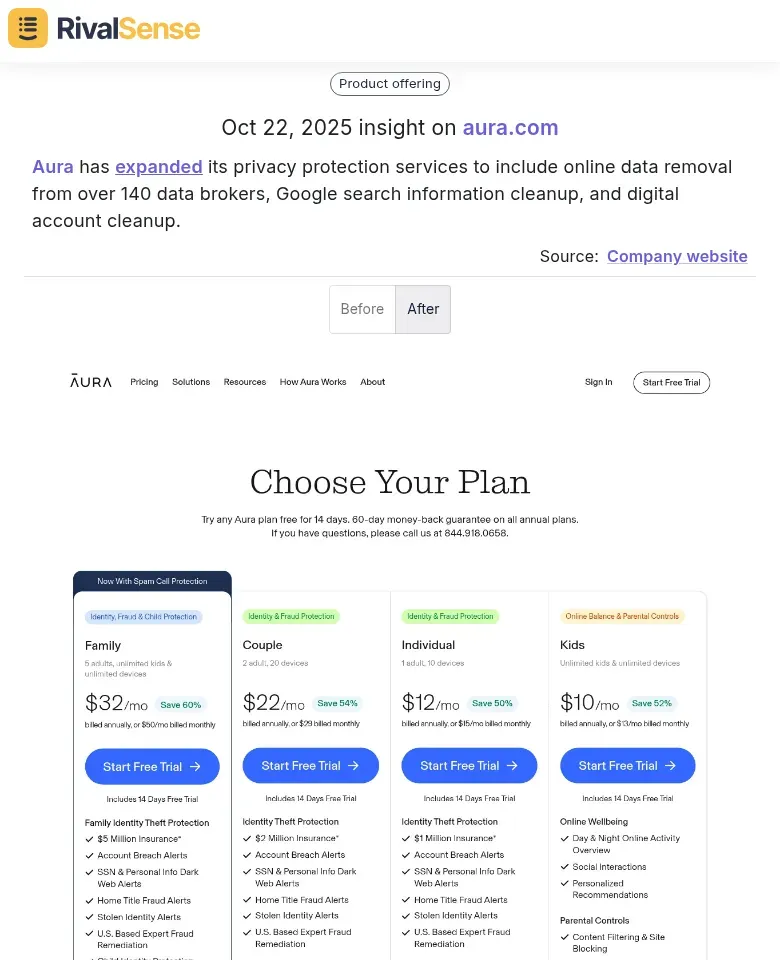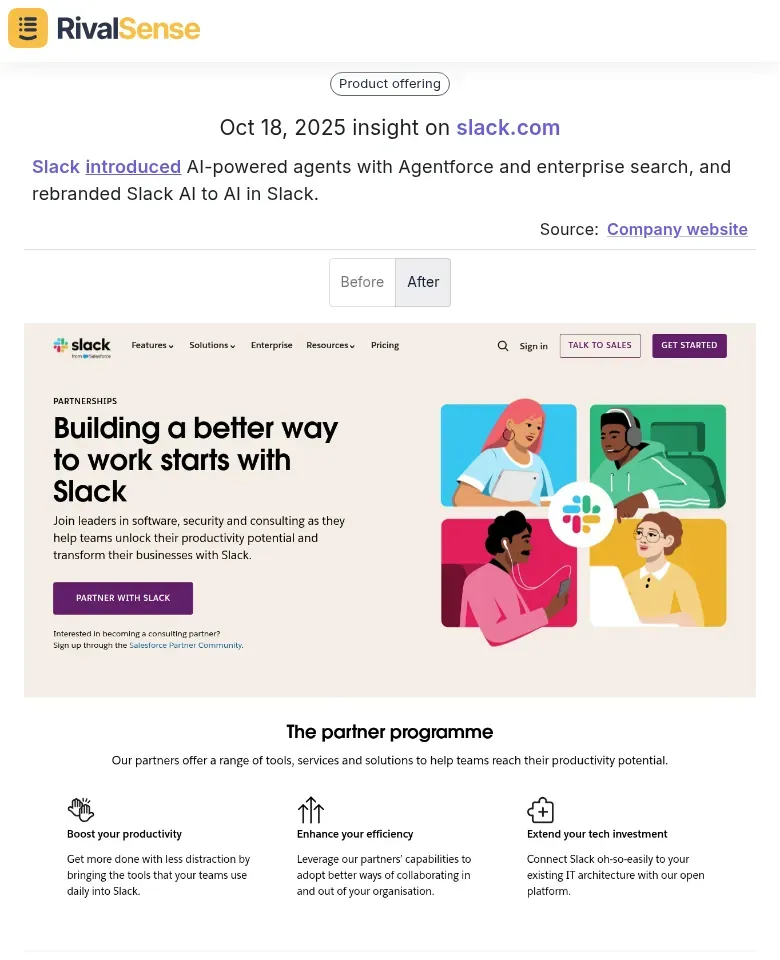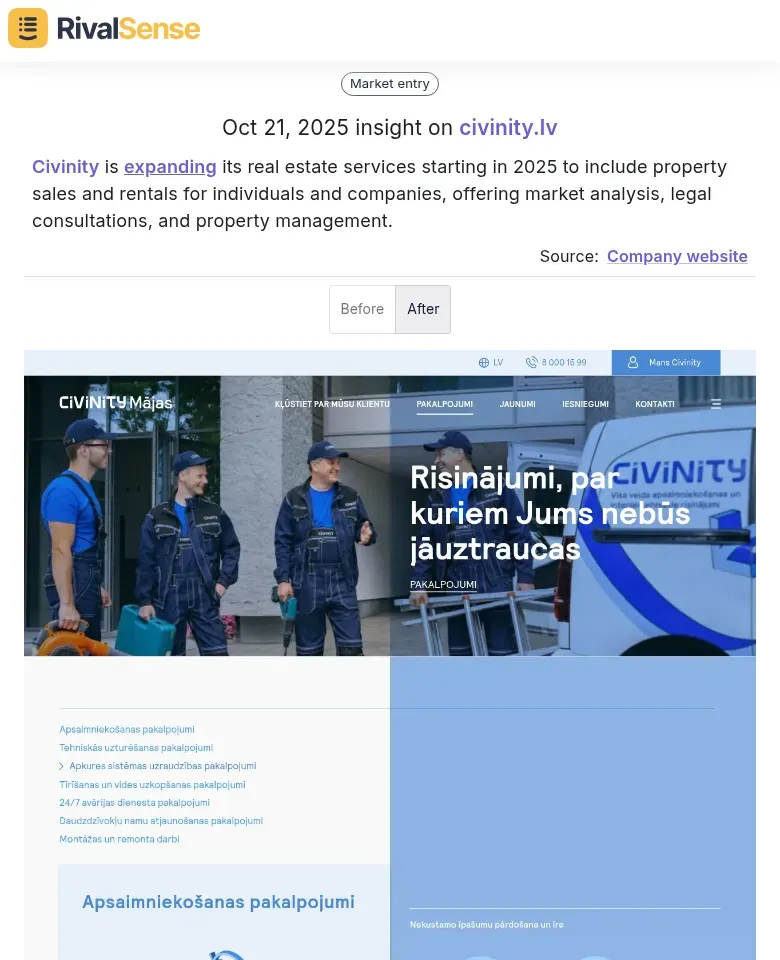Competitor Website Change Framework for Key Account Growth
Competitor website changes are strategic signals that directly impact key account growth. By monitoring these updates, you can uncover shifts in competitor priorities that may threaten your client relationships or reveal new opportunities. For instance, when a rival updates their homepage messaging or pricing, it often precedes targeted sales outreach to your high-value accounts, making proactive tracking essential for defense and expansion.
To leverage this intelligence effectively:
- Monitor homepage messaging, pricing pages, and feature updates weekly
- Set up alerts for competitor blog posts and resource center additions
- Track leadership team changes and new customer announcements
Practical steps to get started:
- ✅ Create a competitor change log with timestamps
- ✅ Map changes to your key account vulnerabilities
- ✅ Develop counter-messaging before competitors approach your clients
- ✅ Use website changes to identify upsell opportunities in existing accounts
By establishing this framework, you transform competitor monitoring from a reactive task into a strategic advantage for retaining and expanding key accounts.
Service Expansion Insights: Learning from Competitor Portfolio Changes
When competitors add new services, they reveal untapped market gaps and evolving customer demands. Tracking these expansions systematically helps you anticipate industry trends and adjust your offerings accordingly. For example, if a rival launches AI-powered analytics, it signals growing demand for data-driven solutions in your niche.
Expanded offerings often create cross-sell opportunities for your business. Analyze how competitors bundle services—like combining CRM with marketing automation—and map these patterns to your key accounts. If a competitor's new service complements your solutions, develop targeted campaigns to capitalize on this overlap.
Checklist for leveraging service expansions:
- ✅ Identify overlapping client segments
- ✅ Assess integration feasibility with your offerings
- ✅ Pilot cross-sell initiatives with a small account group
Consider this real-world example from RivalSense:

Aura has expanded its privacy protection services to include online data removal from over 140 data brokers, Google search information cleanup, and digital account cleanup.
This type of insight is valuable because it highlights emerging consumer privacy concerns and signals where competitors are investing to meet new demands. By monitoring such expansions, you can identify similar gaps in your market and proactively address them before losing key accounts.
AI and Technology Integration: Tracking Digital Transformation Signals
Tracking competitors' AI and technology adoption provides crucial signals about their strategic direction and market positioning. These changes often indicate where the industry is heading, helping you stay ahead of trends. For example, when a competitor launches a chatbot, assessing its focus—customer service or sales—can reveal their operational priorities.
Technology rebranding frequently signals deeper strategic shifts. If a competitor updates their messaging from "cloud-first" to "AI-native," it likely reflects a pivot toward intelligent automation. Monitoring their website's technology sections, press releases on AI partnerships, and executive statements offers insights into their digital transformation journey.
Practical steps to track tech integration:
- ✅ Create a quarterly tech adoption scorecard comparing key competitors
- ✅ Set up alerts for competitor patent filings and technical whitepapers
- ✅ Monitor their GitHub repositories for open-source contributions
- ✅ Analyze customer case studies for implementation patterns
Here's an insight from RivalSense on AI integration:

Slack introduced AI-powered agents with Agentforce and enterprise search, and rebranded Slack AI to AI in Slack.
This insight is valuable because it shows how competitors are embedding AI into core products to enhance user experience and efficiency. By recognizing such moves, you can assess your own AI capabilities and innovate to meet rising customer expectations, ensuring your key accounts don't migrate to more advanced solutions.
Building Your Monitoring Framework: Tools and Processes
Building an effective monitoring framework requires careful tool selection and seamless process integration to keep pace with competitor movements. Start by automating alerts for critical website changes, such as pricing updates or feature launches, to ensure you never miss a strategic shift. This proactive approach helps you respond swiftly to threats and opportunities.
Establish regular review cycles to analyze competitor data—conduct weekly scans for tactical changes and monthly deep-dives for strategic insights. Creating a competitive intelligence dashboard that aggregates website updates, social media activity, and customer feedback streamlines this process and keeps your team aligned.
Practical checklist for framework setup:
- ✅ Identify 3-5 critical website elements to monitor (e.g., pricing pages, feature lists)
- ✅ Set up automated alerts with daily or weekly frequency
- ✅ Create a shared intelligence repository for team access
- ✅ Schedule monthly competitive briefings with key account teams
- ✅ Map competitor changes to specific account action plans
Integrate monitoring with key account workflows by linking competitor changes to client opportunities. For instance, RivalSense tracked this expansion:

Civinity is expanding its real estate services starting in 2025 to include property sales and rentals for individuals and companies, offering market analysis, legal consultations, and property management.
This type of insight is valuable because it reveals competitor entry into new service areas, allowing you to assess potential overlaps with your key accounts and develop preemptive strategies. Automated tools like RivalSense can streamline this tracking, ensuring you capture such expansions early.
From Insights to Action: Translating Changes into Growth Strategies
When competitors update their websites, transforming those insights into actionable growth strategies is key to maintaining a competitive edge. First, analyze competitor moves—like new features or pricing adjustments—to identify gaps they create in the market. For example, if a rival raises prices, you can emphasize your cost-effectiveness in communications with vulnerable accounts.
Second, craft targeted messaging for accounts that might be affected by competitor changes. If a competitor removes a popular service, highlight your superior alternative through personalized demos or emails. This proactive approach helps retain clients and win new ones by addressing their pain points directly.
Checklist for turning insights into action:
- ✅ Track competitor updates weekly and brief your team promptly
- ✅ Update battle cards and sales materials based on new intelligence
- ✅ Run A/B tests on messaging to refine your approach
- ✅ Coordinate sales and marketing efforts for a unified response
By aligning insights with real-time actions, you ensure that competitor monitoring directly fuels key account growth and market positioning.
Measuring Impact and Continuous Optimization
Measuring the impact of your competitor monitoring efforts is essential for refining strategies and scaling success across your key account portfolio. Start by tracking metrics like win rates, client retention, and account expansion to gauge how effectively you're responding to competitor changes. For instance, if a competitor's pricing update correlates with a drop in your win rates, it signals a need for strategic adjustments.
Continuously optimize your framework by refining monitoring parameters based on performance data. If certain updates—such as new case studies—consistently impact retention, prioritize alerts for those changes. This iterative process ensures your approach remains agile and responsive to market dynamics.
Checklist for measurement and optimization:
- ✅ Conduct weekly reviews of metric trends and competitor changes
- ✅ Perform monthly analysis to identify patterns and adjust strategies
- ✅ Schedule quarterly framework refinements with input from sales teams
- ✅ Segment accounts by size or industry for tailored monitoring rules
Involving sales teams in data interpretation provides real-world insights, and A/B testing response strategies helps validate your approaches. By iterating continuously, you stay ahead in dynamic markets and protect your key accounts effectively.
Ready to implement this framework? Try RivalSense for free at https://rivalsense.co/ and get your first competitor report today to start transforming insights into growth!
📚 Read more
👉 Automate Key Account Tracking to Beat Ventilation System Competitors
👉 Boost Productivity with Competitor Product Insights and Intelligence
👉 Leveraging Competitor Milestones for Strategic Insights
👉 Key Account Management Dashboard Examples: Templates, Features, and Building Guide
👉 Cloud Infrastructure Leaders: Key Account Management Strategies for Success
